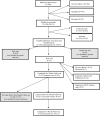Decisional outcomes following use of an interactive web-based decision aid for prostate cancer screening
- PMID: 26029281
- PMCID: PMC4444703
- DOI: 10.1007/s13142-014-0301-0
Decisional outcomes following use of an interactive web-based decision aid for prostate cancer screening
Abstract
Informed decision-making tools are recommended for men considering prostate cancer screening. We evaluated the extent to which use of an interactive, web-based decision aid was associated with decisional and screening outcomes. Participants (N = 253) were 57 (7.0) years old and completed telephone interviews at baseline, 1 month, and 13 months post-baseline. Tracking software captured minutes spent on the website (median = 33.9), sections viewed (median = 4.0/5.0), testimonials viewed (median = 4.0/6.0), and values clarification tool (VCT) use (77.3 %). In multivariable analyses, all four website use variables were positively associated with increased knowledge (p's < 0.05). Complete VCT use and number of informational sections were positively associated with greater decisional satisfaction (p's < 0.05). Decisional conflict and screening behavior were not associated with measures of website use. Increased use of informational content and interactive elements were related to improved knowledge and satisfaction. Methods to increase utilization of interactive website components may improve informed decision-making outcomes.
Keywords: Informed decision making; Patient decision aids; Prostate cancer; Prostate cancer screening.
References
Grants and funding
LinkOut - more resources
Full Text Sources
Other Literature Sources


